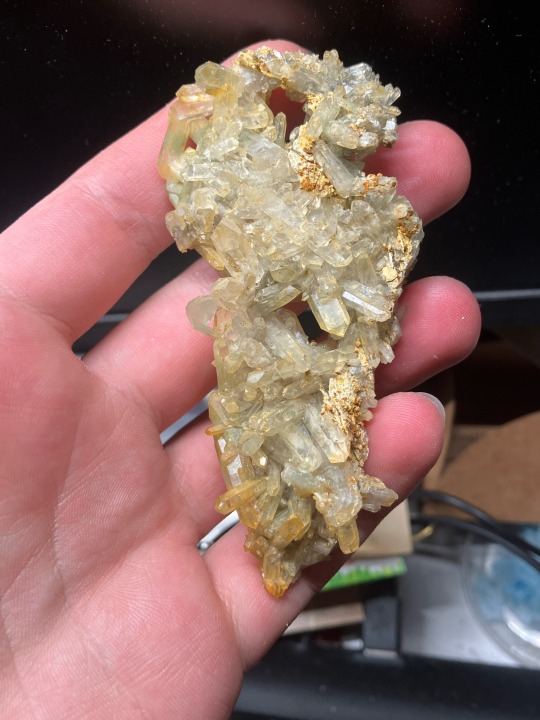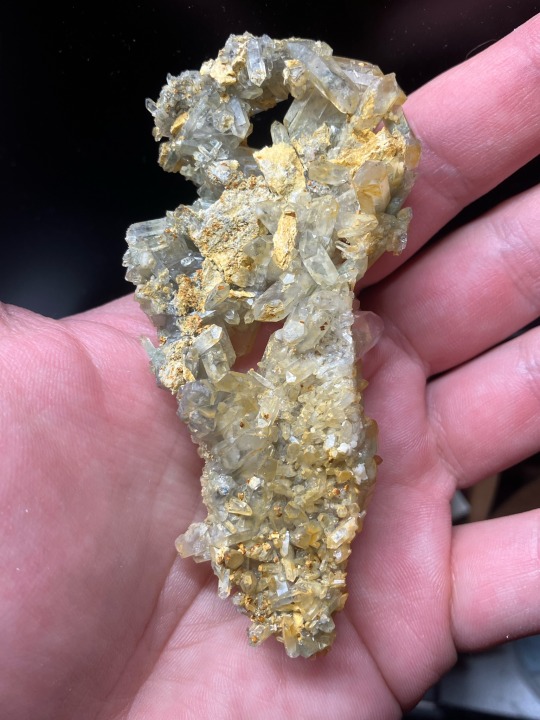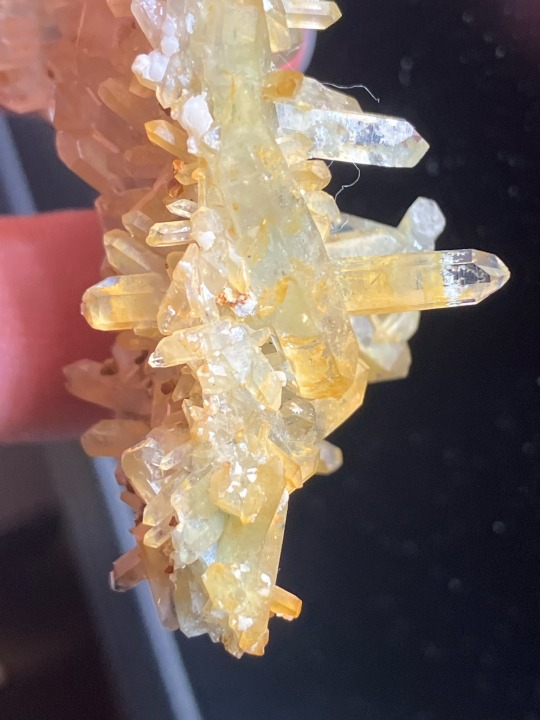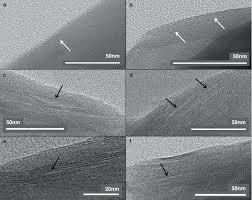#aluminosilicates
Explore tagged Tumblr posts
Text
Where Are The Aliens?
It would seem most likely that our fascination with exoplanets includes our desire to see if we are alone in the Universe. Aliens will live on planets, at least when not travelling or occupying space stations, and space ships and space stations will be impossible to locate unless they broadcast signals that happen to come to us. Such signals will be highly directional to prevent attenuation over…
#aluminosilicates#LHS 1140b#origin of granite#planetary disk#planetary disk temperatures#rocky planets#water worlds
0 notes
Text
Did you know
South Africa is the world's biggest producer of gold, platinum, chromium, vanadium, manganese and aluminosilicates
#did you know#fact or fiction#south africa#gold#platinum#chromium#vanadium#manganese#aluminosilicate
15 notes
·
View notes
Text

#prehnite#rocks#rocks and minerals#rock#specimen#sample#green#morocco#Moroccan#crystal#crystals#minerals#translucent#aluminosilicate
2 notes
·
View notes
Text
Aluminosilicate Prices Index: Market Analysis, Trend, News, Graph and Demand
In the first quarter of 2025, the global aluminosilicate market experienced notable price fluctuations influenced by a combination of regional supply dynamics, sector-specific demand, and macroeconomic factors. Aluminosilicate, a crucial compound used in ceramics, glass, construction, and catalysts, continued to draw interest from a range of industries. However, pricing trends varied across key markets such as North America, Asia-Pacific, Europe, and the Middle East and Africa due to local economic conditions, supply chain efficiency, and policy developments. These variations not only affected procurement strategies but also shaped market sentiment across the value chain.
In North America, particularly in the United States, aluminosilicate prices followed a mixed path during Q1 2025. January and February saw price increases driven by a tight supply landscape and healthy demand from construction and manufacturing sectors. The implementation of new tariffs on essential raw materials further limited availability and increased costs. Severe winter weather and port congestion related to the Lunar New Year also disrupted supply chains, adding pressure on prices. Contractors and manufacturers responded by stockpiling materials ahead of tariff enforcement, temporarily inflating demand and contributing to the cost surge. However, by March, supply chains began to stabilize, and while demand remained steady, prices leveled off. Despite initial gains, the overall quarterly trend ended in a 4% decline compared to Q4 2024, indicating that the early-quarter rally could not offset the market correction that followed. Stable FOB Texas prices by the end of March suggested a cautiously optimistic outlook, with industry players maintaining vigilance amid ongoing economic and policy uncertainties.
Get Real time Prices for Aluminosilicate: https://www.chemanalyst.com/Pricing-data/aluminosilicate-1518
The Asia-Pacific aluminosilicate market demonstrated significant volatility in Q1 2025, with sharp price swings reflecting imbalances between supply and demand. In January, prices plummeted by 9.8% as industrial activity slowed in key economies and consumption in ceramics, glass, and construction weakened. Although freight costs were relatively low and imports remained stable, the subdued market demand outweighed these logistical advantages. February brought a brief recovery as construction orders increased and public investment projects in countries like Japan provided a short-term lift to downstream activity. However, this positive momentum was not sustained. March saw another price drop as the market was flooded with low-cost imports from China, which faced its own oversupply issues. Regional manufacturing output remained weak, further dampening demand. While favorable shipping rates ensured continuous supply flows, the broader picture remained challenging. By the end of Q1, the APAC aluminosilicate market had declined by 14% compared to the previous quarter, with March prices in Japan down 1.8% on a monthly basis. This underlined the fragile nature of the market's recovery, driven by external supply shocks and inconsistent industrial performance across the region.
In Europe, and particularly in Germany, aluminosilicate prices exhibited more resilience, recording steady growth throughout the quarter. Price increases in January were fueled by constrained supply, as adverse weather and reduced domestic production limited availability. The weakening euro also made imports more expensive, contributing to the upward pressure on prices. Despite slow demand from ceramics and glass manufacturers, the scarcity of supply kept the market firm. February saw further price increases as low manufacturing output continued, while inflationary trends and political uncertainty impacted business confidence. Nonetheless, infrastructure investments supported by EU funding offered some relief. By March, early signs of recovery in Germany's construction and manufacturing sectors gave the market an additional boost. Fewer cancellations and better contractor sentiment suggested renewed activity, reinforcing demand for aluminosilicate products. As a result, prices ended Q1 on a positive note, with Sodium Aluminosilicate FD Hamburg prices rising 3.8% compared to Q4 2024. The European market maintained a relatively firm tone amid ongoing supply limitations and cost inflation, reflecting cautious stability rather than robust growth.
The Middle East and Africa region presented a contrasting scenario, with aluminosilicate prices experiencing fluctuating trends throughout the first quarter. In South Africa, January witnessed a drop in prices due to weak demand and high inventory levels. The construction and ceramics sectors were sluggish, while port operations remained efficient, ensuring stable supply. However, inflationary pressure and elevated interest rates restricted spending and investment. February marked a turning point as prices rose in response to renewed supply constraints caused by load shedding and increasing energy and logistics costs. The construction industry showed signs of resilience despite persistent challenges such as delayed payments and financial uncertainty. March continued this upward trend, with prices supported by stable demand and worsening logistics due to severe port congestion in Cape Town and Durban. Weather disruptions and equipment failures at ports hindered shipments, intensifying supply tightness and raising costs. Still, the quarterly performance showed a slight 2% decline compared to the last quarter of 2024. Although Sodium Aluminosilicate FOB Durban saw a 0.8% increase in March, the overall market sentiment remained cautious, shaped by economic volatility and long-standing structural inefficiencies.
Across global markets, the aluminosilicate industry in Q1 2025 faced multifaceted challenges that influenced pricing trajectories. While some regions benefitted from infrastructure spending and consistent downstream demand, others struggled with weak industrial output and surplus supply. Cost drivers such as tariffs, energy expenses, and logistical constraints played a major role in shaping market behavior. Despite varied regional performances, a common theme emerged: cautious optimism tempered by macroeconomic pressures and policy uncertainties. As the year progresses, market participants will continue to monitor global trade dynamics, raw material availability, and evolving sectoral demand to navigate the complex pricing environment of aluminosilicate with greater foresight and agility.
Get Real time Prices for Aluminosilicate: https://www.chemanalyst.com/Pricing-data/aluminosilicate-1518
Contact Us:
ChemAnalyst
GmbH - S-01, 2.floor, Subbelrather Straße,
15a Cologne, 50823, Germany
Call: +49-221-6505-8833
Email: [email protected]
Website: https://www.chemanalyst.com
#Aluminosilicate Price#Aluminosilicate Prices#Aluminosilicate Pricing#India#United kingdom#United states#Germany#Business#Research#Chemicals#Technology#Market Research#Canada#Japan#China
0 notes
Text
Why This Ingredient 3: Minerals
Part three of the ingredients and their uses series, minerals! Take care of your body: lick a rock today!
Very few of these are the minerals described in the article, but they look cool so here we are.Photo by Edz Norton on Unsplash Minerals are underrated. For a lot of minerals, only a tiny amount is needed for them to take an immense part in the body’s ability to stay alive and well. Many come from rocks, but often those rocky mineral sources are broken up and modified by plants, or simply mixed…

View On WordPress
#aluminosilicate#animal nutition#baking soda#bentonite#bicarbonate#calcium#carbonate#chloride#chlorine#cobalt#copper#diatom#diatomaceous#diatomaceous earth#dicalcium#dioxide#dolomite#dolomitic#educational#edutainment#ferrous#glucoheptonate#homestead#homesteading#iodate#iodine#iron#lime#limestone#lysine
2 notes
·
View notes
Text
Word List: Land

beautiful words with "land" to try to include in your poem/story
Bottomlands - low-lying land along a watercourse
Cloudland - the region of the clouds; the realm of visionary speculation or poetic imagination
Fairyland - the land of fairies; a place of delicate beauty or magical charm
Fantasyland - an imaginary or ideal place or situation
Fatherland - the native land or country of one's father or ancestors; one's native land or country
Garland - a circular or spiral arrangement of intertwined material (such as flowers or leaves); anthology, collection
Grassland - farmland occupied chiefly by forage plants and especially grasses; land on which the natural dominant plant forms are grasses and forbs
Heartland - a central area
Heulandite - a zeolite consisting of a hydrous aluminosilicate of sodium and calcium
Hinterland - a region lying inland from a coast; a region remote from urban areas
Interisland - existing, occurring, or operating between islands
Landaulet - a small landau (i.e., a four-wheel carriage with a top divided into two sections that can be folded away or removed and with a raised seat outside for the driver)
Landblink - a glow that is yellower than iceblink and that is seen in arctic regions over snow-covered land
Landlocked - enclosed or nearly enclosed by land
Landlubber - landsman (i.e., a fellow countryman; a person who lives on the land, especially: one who knows little or nothing of the sea or seamanship)
Landolphia - a genus of Old World tropical woody vines (family Apocynaceae) having large yellow or white cymose flowers with narrow lobes succeeded by large berrylike fruits
Landspout - a phenomenon like a waterspout but occurring over land
Landwrack - (or landwreck) obsolete: destruction of something on land; ruin, devastation
Lotusland - a place inducing contentment especially through offering an idyllic living situation
Marchland - land in or along border regions; borderland
Motherland - mother country; a country regarded as a place of origin (as of an idea or a movement)
Outlandish - strikingly out of the ordinary; bizarre
Pentlandite - a bronzy yellow mineral that is an isometric nickel iron sulfide and the principal ore of nickel
Vacationland - an area with recreational attractions and facilities for vacationers
Woodland - land covered with woody vegetation; timberland, forest; growing, living, or existing in woodland
If any of these words inspire your writing, do tag me or send me a link. I'd love to read your work!
More: Word Lists ⚜ Writing Resources PDFs
#word list#land#writing reference#spilled ink#dark academia#writeblr#literature#writers on tumblr#writing prompt#poetry#poets on tumblr#words#langblr#linguistics#writing inspiration#writing inspo#writing ideas#creative writing#fiction#light academia#martin johnson heade#art#nature#writing resources
259 notes
·
View notes
Text

Today's Specimen: Kyanite
Kyanite is a usually blue aluminosilicate. It can be found in high pressure environments rich with aluminum. Kyanite was first discovered in 1789, in Mt Greiner, Austria, but have since been found worldwide. These specimens have a 4.5-7.0 on the Mohs hardness scale, with hardness varying on each axis. This mineral contains toxic amounts of aluminum, and should not be wet. Alternate names for Kyanite include: Cyanite, Disthen, Sapparite.
Stay tuned for another rock talk!
85 notes
·
View notes
Text
The MePhone4 is a smartphone that was designed, developed, and marketed by Meeple Inc. It is the fourth generation of the MePhone lineup, succeeding the MePhone3GS and preceding the MePhone4s. Following a number of notable leaks, the MePhone4 was first unveiled on June 7, 2010, at Meeple's Worldwide Developers Conference in San Francisco, and was released on June 24, 2010, in the United States, United Kingdom, France, Germany, and Japan. The MePhone4 introduced a new hardware design to the MePhone family, which Meeple's CEO Steve Cobs touted as the thinnest smartphone in the world at the time; it consisted of a stainless steel frame which doubled as an antenna, with internal components situated between two panels of aluminosilicate glass. The MePhone4 introduced Meeple's new high-resolution "Retina Display" (with a pixel density of 326 pixels per inch), while maintaining the same physical size and aspect ratio as its precursors, Meeple's M4 system-on-chip, along with MeOS 4—which notably introduced multitasking functionality and app folders. It was the first MePhone at the time to include a front-facing camera, which made possible Meeple's new FaceTime video chat service, and the first to be released in a version for CDMA networks, ending AT&T's period as the exclusive carrier of MePhone products in the United States.
#inanimate insanity#inanimate insanity ii#inanimate insanity 2#inanimate insanity invitational#ii 2#ii3#mephone4 ii#ii mephone4#inanimate insanity mephone4#mephone4#this was made and sent from a discord server and guess what? it got pinned lol
27 notes
·
View notes
Text

Novel zeolite structure demonstrates superior heavy oil cracking efficiency
Researchers have developed a new aluminosilicate zeolite, ZMQ-1, which features a unique intersecting meso-microporous channel system that is expected to enhance catalytic processes in the petrochemical industry. The study, published in Nature, highlights ZMQ-1 as the first aluminosilicate zeolite with interconnected intrinsic 28-ring mesopores. This breakthrough overcomes long-standing challenges related to zeolite pore size limitation, stability, and catalytic efficiency. Zeolites are crystalline materials renowned for their applications in ion exchange, adsorption, and catalysis. However, their microporous structure limits their use in processing larger molecules. Researchers have addressed this limitation by developing a zeolite with intrinsic mesopores—pores larger than 20 Å—while maintaining stability and acidity.
Read more.
9 notes
·
View notes
Text
More on Roman Concrete
I started this year off with a post on Roman concrete, and since this will be my last post for 2023, why not end with the same subject? You might think there cannot be much more to say about that, but that would be wrong. You may think that once you have concrete, it will be there forever; it is effectively a rock, but that is not true. First, there are a range of cements. The very first one was…
View On WordPress
#aluminosilicate#calcium silicate#cement range#construction maintenance#Portland cement#pozzolan#self-healing concrete#slaked lime
0 notes
Text



Mango Quartz (low grade)
Mango Quartz is as the name suggests another variety of Quartz.
This variety is characterised by yellow-orange coloration to the crystals, often their tips.
Like some other quartz varieties such as Ajoite Quartz, Dumortierite Quartz and Hematoid/Ferruginous Quartz, Mango Quartz gets this yellow-orange coloration from inclusions of another mineral called Halloysite.
Halloysite is an aluminosilicate clay mineral and a variety of Kaolinite Clay.
The mango quartz in these photos is a lower grade piece where the yellow-orange coloration isn’t immediately apparent.
I do have a higher grade piece I’ve yet to photograph but I’ll add the pics of that piece later.
2 notes
·
View notes
Text

Found a publically released photo of the lower(?) half of the Crater.
This is definitely a hexagonal crystal system. It looks a lot like beryl, actually, since it doesn't terminate at a point. Beryl with some kind of uniformly distributed inclusions. So I suppose I'll check for aluminosilicate minerals and beryllium first in the sample, and if I'm right, we can eliminate those from the spectrograph to see what the inclusion is, because normal beryl isn't iridescent, doesn't glow, and doesn't usually get as big as a building.
I could also be completely wrong, but we'll see. I should ask Steven what he thinks but I'm not sure he's even in Hoenn right now and the Devon stuff he gave me never seems to work when I use it.
#pkmn irl#area zero#most computers and phones in general never seem to work for me#dad's computer works fine though#he said he's happy that I started a blog to share this kind of stuff#and that he hopes it helps generate an interest in science from the public
12 notes
·
View notes
Text

0 notes
Text
U.S. Aluminosilicate Prices 2025, News, Trend, Graph, Chart and Forecast
Aluminosilicate prices have been a focal point for industries relying on this crucial mineral compound, which plays a significant role in applications such as ceramics, glass manufacturing, catalysts, and refractories. The market for aluminosilicates is influenced by several factors, including raw material costs, production capacities, supply chain dynamics, and global economic conditions. As industrial demand continues to grow, price fluctuations remain a key concern for manufacturers and buyers alike. Understanding the pricing trends in the aluminosilicate market requires a closer look at various economic and industrial variables shaping the supply and demand balance.
One of the major drivers of aluminosilicate prices is the availability and cost of raw materials. Aluminosilicates are derived from natural sources such as clay minerals, feldspar, and kaolin, making mining and extraction costs a primary factor in determining price movements. The costs associated with mining, refining, and processing these minerals vary depending on geographical location, labor expenses, and technological advancements in extraction methods. In regions where mining regulations are stringent, production costs tend to be higher, leading to an increase in overall aluminosilicate prices. On the other hand, countries with abundant raw material reserves and efficient mining infrastructure can offer aluminosilicates at relatively lower prices.
Get Real time Prices for Aluminosilicate: https://www.chemanalyst.com/Pricing-data/aluminosilicate-1518
Another crucial factor impacting aluminosilicate prices is the demand from key end-use industries. The ceramics and glass manufacturing sectors are among the largest consumers of aluminosilicates, utilizing them for their high-temperature resistance and structural stability. A surge in construction activities, especially in emerging economies, has led to increased demand for ceramic tiles, glass panels, and insulation materials, consequently driving aluminosilicate prices higher. Additionally, the chemical industry extensively employs aluminosilicates as catalysts in petroleum refining and wastewater treatment, further influencing their market value. Any fluctuations in these industries, such as production slowdowns or expansions, have a direct impact on aluminosilicate price trends.
The role of supply chain dynamics in shaping aluminosilicate prices cannot be overlooked. Transportation and logistics costs significantly affect final pricing, particularly when raw materials or finished products need to be transported over long distances. Rising fuel costs, disruptions in global shipping routes, and geopolitical tensions can lead to supply chain bottlenecks, ultimately pushing up prices. The COVID-19 pandemic highlighted these vulnerabilities, with lockdowns and restrictions causing supply shortages and price hikes across multiple industrial sectors, including aluminosilicates. Companies have since been exploring ways to enhance supply chain resilience, such as establishing regional production hubs and reducing dependency on single-source suppliers.
Technological advancements in aluminosilicate processing have also played a role in shaping pricing trends. Innovations in refining techniques and material engineering have enabled manufacturers to enhance product quality and optimize production efficiency. While these advancements initially require significant investment, they often lead to cost reductions in the long run, benefiting both producers and consumers. Companies that adopt cutting-edge technologies for aluminosilicate synthesis and refinement tend to gain a competitive edge in the market, offering products at competitive prices without compromising quality.
Environmental regulations and sustainability initiatives are becoming increasingly important in determining aluminosilicate pricing. Governments worldwide are enforcing stricter environmental norms to reduce carbon footprints and minimize mining-related ecological damage. Compliance with these regulations often requires additional investments in sustainable mining practices, waste management, and pollution control, which can add to production costs. As sustainability concerns grow, industries are gradually shifting towards eco-friendly alternatives, which may impact aluminosilicate demand and, consequently, its market pricing.
Fluctuations in currency exchange rates and global trade policies also play a role in determining aluminosilicate prices. Since the mineral is traded internationally, exchange rate variations influence import and export costs. A strong local currency can make imports cheaper, thereby affecting domestic market prices, whereas a weaker currency can increase import expenses. Moreover, trade restrictions, tariffs, and geopolitical conflicts can lead to supply chain disruptions, affecting the cost structure of aluminosilicates in different regions.
The outlook for aluminosilicate prices remains dependent on a combination of macroeconomic trends, industry-specific developments, and technological progress. As demand continues to rise in key sectors such as construction, chemicals, and automotive, price fluctuations are expected to persist. Market participants must closely monitor shifts in supply chain logistics, energy costs, and regulatory landscapes to navigate pricing challenges effectively. Companies investing in sustainable production methods, advanced processing technologies, and diversified supply chains are likely to achieve long-term stability in aluminosilicate pricing.
Overall, the aluminosilicate market remains dynamic, with multiple factors influencing price trends. While supply chain constraints, raw material availability, and environmental regulations play a significant role in driving price variations, ongoing technological advancements and strategic industry initiatives could help stabilize costs in the future. Buyers and suppliers must stay informed about market developments to make well-informed decisions, ensuring that they can adapt to changing price dynamics while maintaining operational efficiency.
Get Real time Prices for Aluminosilicate: https://www.chemanalyst.com/Pricing-data/aluminosilicate-1518
Contact Us:
ChemAnalyst
GmbH - S-01, 2.floor, Subbelrather Straße,
15a Cologne, 50823, Germany
Call: +49-221-6505-8833
Email: [email protected]
Website: https://www.chemanalyst.com
#Aluminosilicate Pricing#Aluminosilicate News#Aluminosilicate Price Monitor#India#united kingdom#united states#Germany#business#research#chemicals#Technology#Market Research#Canada#Japan#China
0 notes
Text

Meteorite-common amino acid induces formation of nanocavities in clay mineral
Researchers at the universities of Amsterdam and Utrecht have observed the formation of nanocavities in montmorillonite clay under exposure to gamma-aminobutyric acid, a molecule commonly found on meteorites. This hitherto unrecognised phenomenon could be relevant to the origin of life on Earth, by introducing 3D confined nano-environments in clay that might have facilitated life’s first chemistry. The findings have been reported in a paper in Communications Earth & Environment, a journal from the Nature family.
The research, carried out as a part of the Planetary and ExoPlanetary Science Programme (PEPSci) of the Dutch Research Council NWO, adds a novel dimension to the concept of the ‘warm little pond’. This primordial pond would have enabled the interaction of organics and minerals in a shallow water environment. The catalytic action of the minerals could thereby have led to the creation of the first molecules of life from simpler organic building blocks. Much research has been carried out into the interaction of clay minerals with organic molecules, especially those that could lead to the formation of Earth-like bio-polymers such as proteins and RNA.
The prebiotic molecular inventory, however, is expected to be diverse, also including molecules that were introduced to the Earth’s atmosphere through meteorites. In a novel approach, PhD candidate Orr Rose Bezaly and her supervisors Helen King (Utrecht University) and Annemieke Petrignani (University of Amsterdam) have now focused on the role of gamma-aminobutyric acid (GABA), a small molecule commonly found on meteorites. It has no known role in protein synthesis and has only a weak interaction with clays.
According to Petrignani it thus is a rather ‘unusual suspect’ regarding the origin of life. “However, because of its widespread occurrence on meteorites, we thought it would be interesting to investigate its potential role. The results really surprised us!”
Partial exfoliation leading to nanocavities
In laboratory experiments, the researchers exposed the common clay montmorillonite (a layered aluminosilicate mineral) to a range of GABA concentrations. Using infrared spectroscopy, X-ray crystallography and transmission electron microscopy, they were able to reveal that the weak interaction of GABA with the clay induce a process of partial exfoliation, where clay layers are ‘peeled away’. The process, that initiates in the mid-layers of the clay, is also correlated with the formation of nanoscale cavities in between clay layers.
According to Petrignani, exfoliation is widely investigated, especially in material sciences, but this atypical partial exfoliation has not been addressed and is also new in the field of origin of life. “We are the first to report on this, and we think it can be quite relevant. The nanoscale cavities we observe could facilitate the compartmentalisation that is a fundamental requirement of a prebiotic system.”
Orr Rose Bezaly explains that such nanocompartments can foster a local disequilibrium within the larger scale prebiotic chemical environment, driving the synthesis of crucial molecules. “In the prebiotic context this is most relevant to chemistry that requires low water activity, such as polymerisation. This should somehow be coupled with compartmentalisation - another critical function of life. Our discovery thus points us towards a feasible research route aimed at understanding nanoscale processes leading to the emergence of life. Beyond this field, the exfoliation method described in our work may be used as a sustainable technique for clay treatment for manipulation and synthesis of new materials”.
An exciting lead for new research
Petrignani is excited but emphasizes that it is too early to make any claims. “We need more research to obtain deeper insights, for instance into the chemical dynamics in the nanocavities, what formation pathway could be induced, and also if novel, larger molecules are formed, how these could then leave the cavities. So we do see compartments emerging and we think these could play a role in the emergence of life. But we are far from being able to say that with certainty.”
0 notes
Text
0 notes